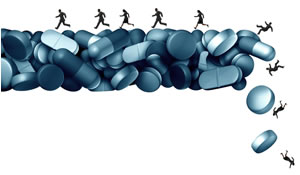Inflammation and Pain Explained
Pain is your body’s warning signal, telling you that something is wrong and you should make some changes.
Inflammation is the root of all disease.
At the same time, it’s also a natural process in your body. Without it, you would be unable to fight-off infections or recover from injuries. But it’s easy to have too much.
While low level, acute inflammation is beneficial, chronic inflammation is potentially devastating. It’s linked to just about every chronic disease and degenerative condition, including many autoimmune diseases, arthritis, osteoarthritis, heart disease, diabetes and even cancer.
It’s becoming an Epidemic!
Today, chronic pain affects more Americans than diabetes, heart disease and cancer – combined! The top three killers.
Chronic pain is from inflammation that’s gotten out of control. It’s the straight path to those top three killers, degenerative and PAINful diseases.
 Every day, millions of people start their work day with sore wrists, aching backs and painful knees – struggling with even the most simple tasks. A large percentage of all those people with inflammatory pain will use non-steroidal Anti-inflammatory Drugs (NSAIDs like Advil, Tylenol, Aleve, Celebrex), despite their well-known side effects. Though it may feel like these drugs win the battle, they are definitely losing the proverbial war on pain.
Every day, millions of people start their work day with sore wrists, aching backs and painful knees – struggling with even the most simple tasks. A large percentage of all those people with inflammatory pain will use non-steroidal Anti-inflammatory Drugs (NSAIDs like Advil, Tylenol, Aleve, Celebrex), despite their well-known side effects. Though it may feel like these drugs win the battle, they are definitely losing the proverbial war on pain.
If you’re a high performance athlete (with niggling or major injuries), or if you’re a sedentary type that does not enjoy exercise at all, we have many NATURAL solutions for Pain and Inflammation.
Big Warning ~ About Pain Relief Medications
Can my joint pain be caused by a lack of Advil?
Well of course not!
If you’ve been diagnosed with arthritis, your doctor will recommend pain relief medications: Nonsteroidal Anti-inflammatory Drugs (NSAIDs like Advil and Tylenol) – despite their well-known side effects.
NSAIDs and pain relievers (analgesics) – they help you to feel better by reducing discomfort, but they do not stop the process of degenerating joints!
I found out that – in fact – NSAIDs make joints worse in the long run! ~ Yikes!
Research indicates that NSAIDs actually accelerate the progression of joint destruction, causing more problems down the road.
Here’s how:
The good news about NSAIDs is that they reduce your pain, by blocking enzymes that are involved in the production of inflammatory compounds.
BUT… NSAIDs also inhibit enzymes that manufacture cartilage components!
You may be temporarily pain-free, but your joints are silently getting worse!
Several clinical studies have shown that NSAID use
is associated with acceleration of osteoarthritis
and increased joint destruction!!!
Pain is your body’s warning signal, telling you that something is wrong and you need to make some changes. We can help…
 NSAIDs mess with Mother Nature and can cause more grief that they’re worth.
NSAIDs mess with Mother Nature and can cause more grief that they’re worth.
Research indicates that these drugs actually accelerate the progression of joint destruction, causing more problems down the road. NSAIDs reduce pain by blocking enzymes that produce inflammatory compounds. But also…
NSAIDs block enzymes that manufacture your cartilage!
You may be temporarily pain-free, but your joints are silently getting worse!
Several clinical studies have shown that NSAIDs are associated with the acceleration of joint destruction and osteoarthritis. They help you feel better by reducing inflammation and pain, but they don’t stop disease progression and aging. They cannot prevent bone and joint destruction.
Read the research in this article:
Long term use of analgesics and risk of osteoarthritis
So we absolutely recommend NATURAL solutions for Pain and Inflammation.
Powerful anti-inflammatory compounds may quell pain and inflammation just as effectively as NSAIDs, but without the potential health risks.
Why expose yourself to common – and dangerous – side effects of traditional pain meds (stomach pain, ulcers, headaches, dizziness, allergic reactions, high blood pressure) that only mask the pain? They do not address the root cause.
Get rid of the origin of your pain – inflammation, and support your heart and brain health!
Sooner or later each one of us will experience some type inflammation. Medical diagnosis of your problem will have an “itis” at the end. The four signs of inflammation – redness (Latin rubor), heat (calor), swelling (tumor), and pain (dolor) – were described in the 1st century AD by the Roman medical writer Aulus Cornelius Celsus. Typical encounters with inflammation will include otitis, or ear infection, pharyngitis, or sore throat, and common aches and pains of latter years such as arthritis and myositis (muscle aches), and finally in old age we deal with neuritis (brain inflammation or Alzheimer’s) or carditis (heart disease).
Inflammation cuts across traditional orthodox medicine boundaries and specialties. Inflammation is characterized by pain, fatigue and aging, and is recognized by tissue swelling, redness, heat and pain. These symptoms are very obvious with an injury or an infection such as a sore throat. But our concern is not only our acute response to injury or infection, it is the chronic smoldering inflammation that slowly destroys our organs and our ability to function. Low level inflammation leads to rapid aging.
Common orthodox treatments such as anti-inflammatory drugs (NSAIDs), or steroids like prednisone, can suppress acute symptoms, at the price of interference with the body’s own immune response. This interference has serious and deadly side effects that come into play later. As a point of interest, national statistics show that same number of people die from taking anti-inflammatory drugs (i.e. ibuprofen) as people who die from asthma or leukemia. We don’t do well with inflammation in our body. Taking pain killers and other signal suppressants simply blocks your pain, it does not deal with the causes any better than covering up a warning light on your dash board will deal with dropping oil pressure in your car’s engine. Inflammation is one of the core forces, integrally linked to all the others – problems with malnutrition, metabolism, detoxification and oxidative stress will interfere with our ability to maintain cellular terrain balance that keeps inflammation in check.
The inflammation we refer to occurs systemically throughout the body, not just in one isolated spot, so problems that trigger inflammation in one area, like the gut, can produce inflammation at a far distant site such as the brain. The list of factors that incite inflammation is fairly limited. These factors cause changes in our digestive function and gut environment creating a “leaky gut”, and at the same time cause changes in liver detoxification, as well as in our immune, hormonal and nervous systems. Problems with all these areas trigger an excessive amount of oxidative stress feeding the fire of inflammation. Thus begins a cascade of inflammation controlled by the chemical messengers of the immune system gone wild. It is a self-amplifying and self-perpetuating process.
Oddly enough, one causative issue can lead to vastly different outcomes: consider a gluten or wheat allergy causing both a skin rash and (or) an autoimmune thyroid condition. The same intervention or treatment would be used to treat both of these conditions. Alzheimer’s is a name for a condition of a brain that has been damaged and scarred by inflammation. A heart attack is caused by a clot plugging an artery in the heart – the clot is a result of plaque forming in the arteries as a reaction to internal inflammation. You won’t necessarily notice low levels of inflammation – you won’t feel it until it is quite advanced. It has many causes, including toxins, allergens, lack of oxygen, lack of antioxidants, too many free radicals, infections, obesity, and blood sugar problems.
A recent study of a generally “healthy” elderly population found that those with the highest levels of C-reactive protein and interleukin-6 (two markers of systemic inflammation) were 2.6 times more likely to die during the next 4 years. The increase in deaths was due to both cardiovascular and other causes. We may feel healthy, but if this inflammation is raging inside of us, we are in trouble. [Harris TB. Associations of elevated interleukin-6 and C-reactive protein levels with mortality in the elderly. American Journal of Medicine, May 1999;106(5):506-512.]. The authors of the study concluded that these measures (C-reactive protein and interleukin-6) might be useful for identification of high-risk subgroups for anti-inflammatory interventions.
Normally your body maintains a balance between the inflammatory molecules and the anti-inflammatory molecules, but as those molecules come out of balance, we begin to overheat. The chemical causes of inflammation are mostly influenced by diet and other lifestyle choices. These causes, or mediators, fall into two major categories: eicosanoids (prostaglandins, prostacyclins, leuokotrienes, thromboxanes) regulated mostly by the fats we eat (fish oil creates anti-inflammatory eicosanoids, while beef fat creates inflammatory eicosanoids); and cytokines that are the “neurotransmitters” of the immune system (interferon, interleukins, tumor necrosis factor, etc.). When in balance, our bodies keep everything running smoothly, when out of balance, the fire of inflammation rages out of control.
The good news is that by rooting out the causes through dietary and lifestyle choices you can restore balance in the forces of immunity and inflammation. You must reduce physical, mental and emotional stress – through lifestyle choices, changes in environment, diet, specific nutrients and behavioral changes – the fires of inflammation can be cooled off, the symptoms of pain, fatigue and aging stopped and health restored.
![[EMEC6] Intense C60](/web/image/product.template/3233/image_1920/%5BEMEC6%5D%20Intense%20C60?unique=9be4757)
![[NSPPW] PolarPOWER](/web/image/product.template/3368/image_1920/%5BNSPPW%5D%20PolarPOWER?unique=ae82545)
![[PTTU] Turmeric](/web/image/product.template/3481/image_1920/%5BPTTU%5D%20Turmeric?unique=ae82545)